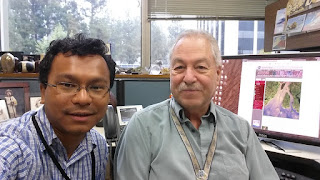One of the fascinating argument of Einsteins' theory of General Relativity can be simply illustrated by the foam-ball diagram. Where a heavy ball put on the surface would produce a curvature. Thereby generating the deformation so that if a lighter ball is rolling nearby, it would cause the ball to roll towards the bigger ball.
Similarly, if we imagine that the space-time that our universe resides is a giant surface in 4-dimension, then we can argue that things that have mass will cause that surface to bend. In other words, the matter will tell the spacetime where to bend while the spacetime curvature will then dictate how the mass will travel. The more "heavy" the mass, the more bending. Ultimately, the heavy "mass" or huge Energy, can cause a hole in the fabric of spacetime. That we call the black hole!
What is interesting is that we can imagine traveling from point A to B. If the amount of effort that is required is called as action, then naturally one tends to minimize the action. The most straightforward way to minimize the action in two dimension is a straight line! Now, if you were in four dimension, and wanted to go from point (need to call it a four-point as it has four co-ordinates) A to point B. Then naturally, it would be a "straight" line in 4D! However, the manifestation of the space and time makes it look like a curved line near the "heavy" masses. That's the reason behind the orbits of the planets. You may ask: but, aren't the planets coming back to the same positions after one planetary year? Yes, that is right in space. But in time, you moved one year's worth of journey! Think about it!
That means there is no force which is pulling things around. It is just the manifestation of the bending of the spacetime fabric.
When masses accelerate, gravitational waves are produced. This can cause "ripples" in the space!
The LIGO experiment, (LIGO: The Laster Interferometer Gravitational-Wave Observatory) was designed in 1992. It is a large-scale physics experiment to detect gravitational waves. It consists of 4 km long tunnels in L-shape. LASER
interferometry is used to detect any change in the fabric of space due to the gravitational wave. Interferometry go about finding changes in the distance between the points A and B by using the principle of superposition of the waves, by measuring the change in the fringes due to shifting of the reflecting mirrors for example. This works because when two waves with the same wavelength/frequency meet, their fates are determined by the phase difference between the waves. The waves in phase will undergo constructive interference and the out-of-phase will undergo destructive interference [
See this video: https://www.youtube.com/watch?v=J_xd9hUZ2AY More specifically this one :
https://www.youtube.com/watch?v=oUytkiBwXvI].
In the case of LIGO experiment, the primary interferometers consist of mirrors suspended at each corners of the L-shaped vacuum tube (4km long). A LASER beam is used to monitor the interference patterns called fringes. When a gravitational wave passes through the interferometer site, the fabric of spacetime is affected. Since the instrument is L-shaped, one side will be stretched while the other side is compressed. This changes the phase of the reflecting waves causing the phase difference between the ends of the L-tube, and thus the wave should be detected!!!
The LIGO has to detect the distortion of 10^(-18) m in space for the light that reflects off the 4-km long tunnel! This is the length less than one thousandth of the diameter of a proton (fm=10^-15). Moreover, since there are two LIGO experiment sites(
 46°27′18.52″N119°24′27.56″W and
46°27′18.52″N119°24′27.56″W and
 30°33′46.42″N90°46′27.27″W
30°33′46.42″N90°46′27.27″W), triangulation method can be used to find the source of the ripple!
Here is a nice video explaining the method
Now here comes the big news!
LIGO has detected the gravitational wave!!!
The authors claim that the signals came from two merging black holes, each about 30 times the mass of our sun, lying 1.3 billion light-years away.
The scientific paper is here:
If you are interested in the press release,
Disclaimer: These are my personal notes. Please draw conclusions at your own risk.





